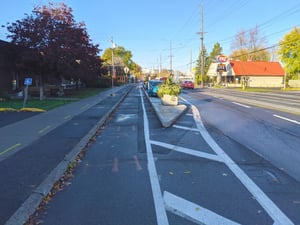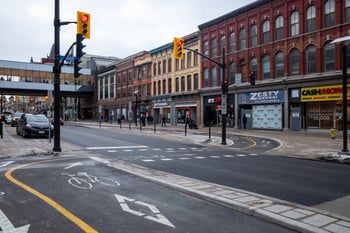Retrofitting Existing Corridors for Bike Lanes
Transforming Urban Quarters: A Guide to Retrofitting Existing Corridors for Sustainable Cycling Facilities
In today's urban landscape, the demand for sustainable and active transportation options has never been more apparent. Retrofitting existing corridors with bike lanes has emerged as a powerful solution for cities aiming to reduce congestion, lower emissions, and promote healthier lifestyles.
Our focus is on achieving a delicate balance between the needs and wants of our clients to seamlessly integrate cycling facilities into established corridors. The Morrison Hershfield team works with municipalities seeking to enhance their transportation infrastructure and provide accessible and sustainable options for their communities. We provide our clients with valuable insights into upgrading existing corridors with active transportation facilities, even in their absence. We explore different types of active transportation facilities currently in use and discuss design considerations to select the most suitable option based on the project's context, all while minimizing capital costs.
Understanding Retrofitting: A Delicate Balance 
Retrofitting involves strategically adding new elements to an existing corridor without fundamentally altering its core purpose. It's a cost-effective approach that minimizes disruption to the current use of the corridor. Distinguishing between retrofitting and reconstruction is vital, as the former strategically adds elements, while the latter involves significant changes to the roadway.
 Types of Cycling Facilities: Protected and Unprotected
Types of Cycling Facilities: Protected and Unprotected
Two primary types of bike facilities are considered in retrofitting projects: protected and unprotected bike lanes. Protected facilities feature physical barriers or grade separations, ensuring cyclist safety. On the other hand, unprotected facilities, marked by paint or shared-use lanes, offer flexibility but come with their own set of considerations. The choice between the two depends on the road context and project requirements, with protected facilities being suitable for high-speed arterial roads and major collector roads.
 Balancing Needs, Budget Constraints, and Stakeholder Involvement
Balancing Needs, Budget Constraints, and Stakeholder Involvement
Striking a balance between clients' desires and budget constraints is a crucial aspect of retrofitting projects. Different facility types come with varying costs, with protected bike lanes typically requiring more funding due to the addition of physical barriers. Involving stakeholders is integral to success, considering their concerns about on-street parking changes or conflicts between cyclists and buses. Consultation and gathering feedback are crucial to understanding and addressing their needs.
Guiding Principles and Regulations
Guiding principles are emphasized, including adherence to traffic laws, the use of resources like transportation association guidelines, and ensuring accessibility for all. Following specific guidelines and regulations, such as the Ontario Highway Traffic Act and accessibility standards, is essential to ensure that the facilities are accessible to all users.
Creating a Sustainable Urban Environment 
Retrofitting existing corridors for bike lanes is a critical step towards creating healthier and more accessible cities. It encourages active transportation, reduces congestion, lowers emissions, and promotes a sustainable urban environment. Safety, efficiency, and accessibility remain paramount in all retrofitting projects.
Embracing Sustainable Urban Transformation
This overview scratches the surface of retrofitting existing corridors for cycling facilities. Balancing the needs and desires of clients, considering various facility types, and staying abreast of innovations are vital elements for successful implementation. By committing to retrofitting, we contribute to a sustainable, accessible, and healthy urban environment, creating cycling facilities that enhance our quarters and make our cities more livable for all.
Written by:
Will Rose, P.Eng. (ON, BC, YK), Project Manager / Active Transportation Lead
Contact: WRose@morrisonhershfield.com

Posts by Topic
Topics
- 5G (1)
- ACEC (3)
- Active Transportation (5)
- AFP/P3 (6)
- Alberta (5)
- Anniversary (1)
- approvals (1)
- Architect (2)
- Atlanta (2)
- Awards (62)
- Biophysical Sciences (1)
- Board of Directors (1)
- Bridge Rehabilitation (3)
- Building and Facilities Engineering (2)
- Building Energy (25)
- Building Envelope (48)
- Building Science (65)
- Calgary (2)
- Canada 150 (1)
- Canstruction (2)
- Capabilities (1)
- Carbon emissions (2)
- Carbon Pathfinder Tool (1)
- Carson Awards (5)
- Charity (13)
- Climate Adaption (7)
- climate change (7)
- Code and Life Safety (8)
- Commercial Buildings (4)
- Commissioning (11)
- Construction (2)
- Construction Administration (5)
- Consulting Engineering (1)
- Critical Facilities (33)
- CSR (24)
- Culture (5)
- Dallas (1)
- Data Center (22)
- Data Center Commissioning (9)
- Data Center Design (12)
- design (9)
- Design Build (1)
- DSSP (1)
- edgecomputing (1)
- edgetechnologies (1)
- Edmonton (4)
- Electrical (24)
- Electrical engineering (8)
- Energy (8)
- Engineers Canada (5)
- Environmental (36)
- Environmental Compensation (1)
- Environmental Impact Assessment (3)
- environmental planner (3)
- Environmental Planning (5)
- ETFE (1)
- Event (12)
- Existing Buildings (6)
- Facade Engineering (4)
- Ferry Docks (2)
- FIDIC (3)
- fisheries biologist (1)
- Flood Mapping (1)
- Florida (1)
- Forensic Investigation (1)
- Fundraising (11)
- garage (2)
- Gender Diversity (8)
- Gender Intelligence (3)
- Geometric Design (2)
- Government (14)
- Hospitality (1)
- Houston (4)
- Hydro (2)
- India (1)
- industrial (4)
- Infrastructure (28)
- Innovation (1)
- interchange (1)
- IWD (2)
- IWD2021 (1)
- Land Development (8)
- Landfill (4)
- Manitoba (1)
- MCF (3)
- Mechanical (21)
- Mechanical Engineering (1)
- MEP (1)
- mission critical (10)
- Moncton (1)
- Motivational MH'er (1)
- Multi-Use Pathways (1)
- Municipal Infrastructure (5)
- municipal solid waste (2)
- MUP (1)
- New Brunswick (1)
- New Hire (17)
- New Role (3)
- Newsroom (121)
- northern communities (2)
- NVTC (2)
- ontario (1)
- Operations Consulting (8)
- Ottawa (2)
- Panel (3)
- People (124)
- Project Management (6)
- QAP (1)
- Rail (1)
- Reconstruction (1)
- regulatory (1)
- Renewable Energy (2)
- resiliency (3)
- Risk Management (1)
- Roads and Highways (3)
- Salt Lake City (1)
- Seattle (1)
- Security (4)
- Social Responsibility (30)
- Solid Waste (11)
- solid waste management (5)
- St Johns (2)
- Stantec (1)
- Structural (14)
- Sustainability (23)
- Telecom (9)
- Texas (1)
- Toronto (13)
- towers (1)
- Traffic Assessment (2)
- Transfer Station (1)
- Transit (13)
- Transit Consultant (3)
- Transit Infrastructure (3)
- Transit Planning (2)
- Transportation (30)
- Transportation Engineering (8)
- transportation structures (2)
- TTC (1)
- Vancouver (6)
- Virginia (2)
- Washington DC (3)
- Waste to Energy (2)
- Water & Wastewater (8)
- Water Resources (3)
- wellfield (1)
- wellness challenge (1)
- Whistler (1)
- Whitehorse (1)
- Wireless (2)
- Women in Engineering (5)
- Yukon (5)